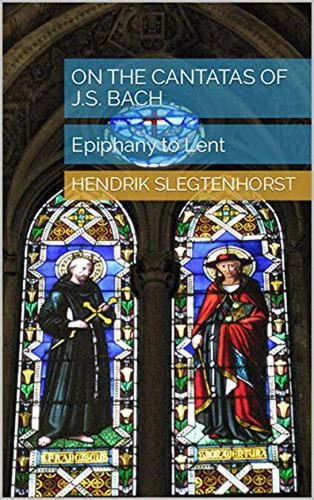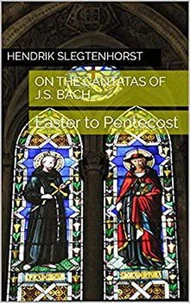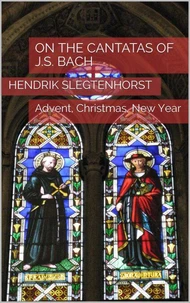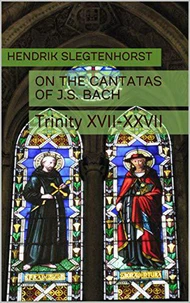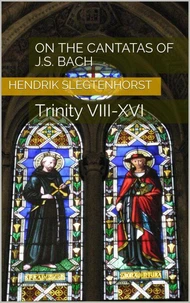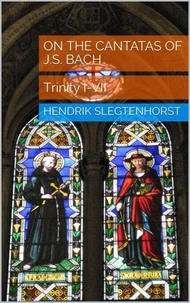On the Cantatas of J.S. Bach: Epiphany to Lent. The Bach Cantatas, #5
Par :Formats :
Disponible dans votre compte client Decitre ou Furet du Nord dès validation de votre commande. Le format ePub est :
- Compatible avec une lecture sur My Vivlio (smartphone, tablette, ordinateur)
- Compatible avec une lecture sur liseuses Vivlio
- Pour les liseuses autres que Vivlio, vous devez utiliser le logiciel Adobe Digital Edition. Non compatible avec la lecture sur les liseuses Kindle, Remarkable et Sony
 , qui est-ce ?
, qui est-ce ?Notre partenaire de plateforme de lecture numérique où vous retrouverez l'ensemble de vos ebooks gratuitement
Pour en savoir plus sur nos ebooks, consultez notre aide en ligne ici
- FormatePub
- ISBN8201393328
- EAN9798201393328
- Date de parution26/01/2022
- Protection num.pas de protection
- Infos supplémentairesepub
- ÉditeurJL
Résumé
In his more than 200 cantatas Bach interprets the human condition through musical assertion and examination of the relevance of the gospels and epistles of the Christian Bible. Every cantata is discussed in my six book series On the Cantatas of J. S. Bach. The epistle, which is essentially didactic, is from the Apostolic letters retained in Scripture. The gospel, which is concerned with the life and teachings of Christ, is effectively an exposition of His adherence to principles and the application of action. Guided by this context, Bach consistently propounds surpassing interpretations of the nature and spirit of life.
Though the over-reaching principles are philosophical and ethical, how they apply is determined, ultimately, by the individual. Book Five of this series examines the 40 surviving cantatas for the Sundays and feast days from Epiphany to Lent, and includes three sacred and two secular wedding cantatas, a cantata for the installation of a town council, and three secular congratulatory cantatas. The religious cantatas are grouped into the period for Epiphany (fourteen cantatas), Purification of the Blessed Virgin Mary (four cantatas), the ten cantatas for the pre-Lenten Sundays (Septuagesima, Sexagesima, Quinquagesima), Annunciation (one cantata), and Lent (two cantatas). Bach, in these, affirms and explains such fundamental aspects as mortal death and immortal re-birth, the manifestation of divinity in human form, and self-assessment and penitential preparation. It is a personal exploration, both his and mine.
Though the over-reaching principles are philosophical and ethical, how they apply is determined, ultimately, by the individual. Book Five of this series examines the 40 surviving cantatas for the Sundays and feast days from Epiphany to Lent, and includes three sacred and two secular wedding cantatas, a cantata for the installation of a town council, and three secular congratulatory cantatas. The religious cantatas are grouped into the period for Epiphany (fourteen cantatas), Purification of the Blessed Virgin Mary (four cantatas), the ten cantatas for the pre-Lenten Sundays (Septuagesima, Sexagesima, Quinquagesima), Annunciation (one cantata), and Lent (two cantatas). Bach, in these, affirms and explains such fundamental aspects as mortal death and immortal re-birth, the manifestation of divinity in human form, and self-assessment and penitential preparation. It is a personal exploration, both his and mine.
In his more than 200 cantatas Bach interprets the human condition through musical assertion and examination of the relevance of the gospels and epistles of the Christian Bible. Every cantata is discussed in my six book series On the Cantatas of J. S. Bach. The epistle, which is essentially didactic, is from the Apostolic letters retained in Scripture. The gospel, which is concerned with the life and teachings of Christ, is effectively an exposition of His adherence to principles and the application of action. Guided by this context, Bach consistently propounds surpassing interpretations of the nature and spirit of life.
Though the over-reaching principles are philosophical and ethical, how they apply is determined, ultimately, by the individual. Book Five of this series examines the 40 surviving cantatas for the Sundays and feast days from Epiphany to Lent, and includes three sacred and two secular wedding cantatas, a cantata for the installation of a town council, and three secular congratulatory cantatas. The religious cantatas are grouped into the period for Epiphany (fourteen cantatas), Purification of the Blessed Virgin Mary (four cantatas), the ten cantatas for the pre-Lenten Sundays (Septuagesima, Sexagesima, Quinquagesima), Annunciation (one cantata), and Lent (two cantatas). Bach, in these, affirms and explains such fundamental aspects as mortal death and immortal re-birth, the manifestation of divinity in human form, and self-assessment and penitential preparation. It is a personal exploration, both his and mine.
Though the over-reaching principles are philosophical and ethical, how they apply is determined, ultimately, by the individual. Book Five of this series examines the 40 surviving cantatas for the Sundays and feast days from Epiphany to Lent, and includes three sacred and two secular wedding cantatas, a cantata for the installation of a town council, and three secular congratulatory cantatas. The religious cantatas are grouped into the period for Epiphany (fourteen cantatas), Purification of the Blessed Virgin Mary (four cantatas), the ten cantatas for the pre-Lenten Sundays (Septuagesima, Sexagesima, Quinquagesima), Annunciation (one cantata), and Lent (two cantatas). Bach, in these, affirms and explains such fundamental aspects as mortal death and immortal re-birth, the manifestation of divinity in human form, and self-assessment and penitential preparation. It is a personal exploration, both his and mine.

